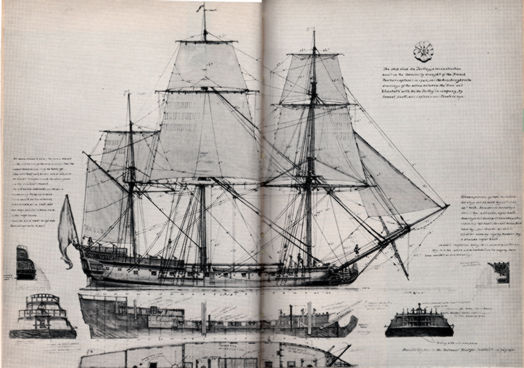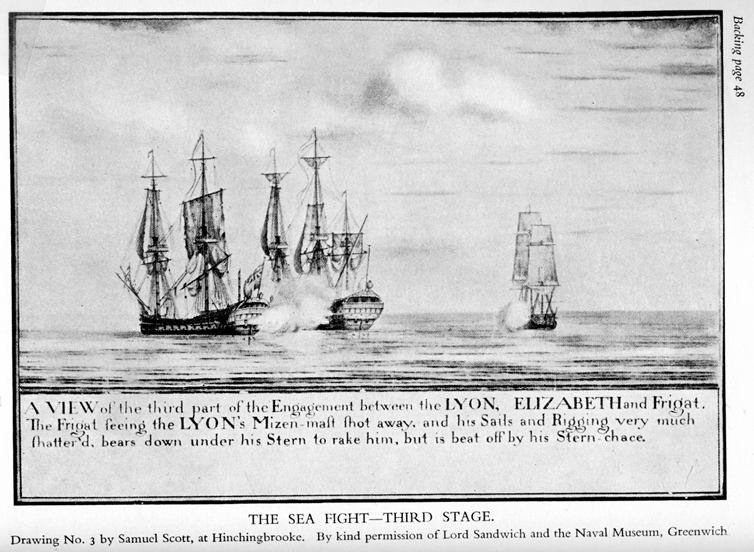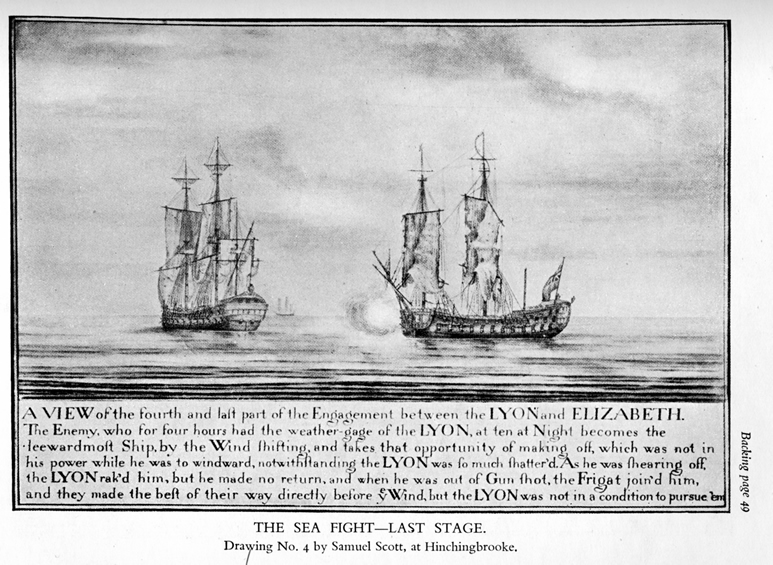
Ascanius; or, the Young Adventurer
Bestselling book of the 18th and 19th centuries
home
From a drawing commissioned by the National Trust for Scotland from Harold Wyllie on 26th July 1965. |
The ship's log of the voyage that brought Prince Charles Edward Stuart to Scotland is here.
The Hinchingbrooke drawings are referred here. Engagement between the Ships "Lion" and "Elizabeth," 1745. By Samuel SCOTT. This desperate, and sanguinary engagement was fought on the 9th of July, 1745. The "Lion" had fifty-eight guns, and four hundred and forty men, and was commanded by Captain Piercy Brett. The "Elizabeth," a sixty-four gun ship, was convoying another, of sixteen guns, with the Pretender on board. They fought for five hours, within pistol shot of each other, during which time, the frigate, with the Pretender on board, managed to make her escape. The "Elizabeth" also at length, effected her entrance into Brest Harbour. She had £400,000 on board, for the use of Charles Edward. The "Lion," unable to pursue, lay a complete wreck on the water. The actual location of the battle is not entirely clear - according to Johnstone it was Sea battle 47° 57' N and 39 leagues west of the Lizard. By the Log of the Du Teillay: Wednesday 21 July N.S. (9 July O.S.) This is from Biographia navalis; or, Impartial memoirs of the lives and Character of officers of the Navy of Great Britain—Volume 5 By John Charnock – London 1797 Page 240.
Samuel Scott (1702-1772) Painted for Admiral, Lord Anson (1682-1762) and placed in the Hall at Shugborough, Staffordshire. Friday 23 July, 1745 NS continuing for Scotland.
A VIEW of the third part of the Engagement between the LYON, ELIZABETH and Frigate. The Frigate seeing the LYON's Mizen mast shot away and his Sails and Rigging very much shatter'd, bears down under his Stern to rake him, but is beat off by his Stern chace. THE SEA FIGHT—THIRD STAGE.
A VIEW of the fourth and last part of the Engagement between the LYON and ELIZABETH. The Enemy, who for four hours had the weather gage of the LYON, at ten at Night becomes the leewardmost Ship, by the Wind shifting, and takes that opportunity of making off, which was not in his power while he was to windward, notwithstanding the LYON was so much shatter'd. As he was shearing off, the LYON rak'd him, but he made no return, and when he was out of Gun shot, the Frigate join'd him, and they made the best of their way directly before ye Wind, but the LYON was not in a condition to pursue them. THE SEA FIGHT—LAST STAGE. According to Le Maréchal de Camp Baron de Warren by Léon Lallement—L’Élisabeth arriva à Brest également en très mauvais état le 27. Here is a very large Map showing the route of the Du Teillay (La Doutelle). |




